![[Flag of Colombia]](../images/c/co.gif) (2:3)
(2:3)  image by Željko Heimer, 20 May 2001
image by Željko Heimer, 20 May 2001
Last modified: 2024-03-02 by rob raeside
Keywords: education |
Links: FOTW homepage |
search |
disclaimer and copyright |
write us |
mirrors
![[Flag of Colombia]](../images/c/co.gif) (2:3)
(2:3)  image by Željko Heimer, 20 May 2001
image by Željko Heimer, 20 May 2001
See also:
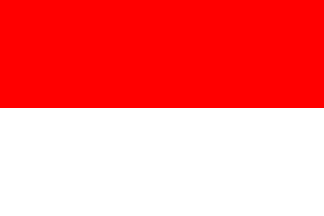 image by Ivan Sache, 01 July 2014
image by Ivan Sache, 01 July 2014
Colegio Parroquial Santiago Apóstol was established in 1960 in
Funja by the parish priest Cesar Hernando Torres
Martinez.
The flag of the institute is horizontally divided red-white. The flag is similar
to the flag of Funja; at the time, the institute was the only one in the town
with official support by the municipality.
Source:
http://www.colsaf.org/colsaf_j/images/circulares/MANUAL_DE_CONVIVENCIA_2014.pdf
- Institute's Constitution
Photos:
http://www.colsaf.org/colsaf_j/images/galeria/IMG_0189.JPG
http://www.colsaf.org/colsaf_j/images/galeria/IMG_0199.JPG
http://www.colsaf.org/colsaf_j/images/galeria/IMG_0216.JPG
http://www.colsaf.org/colsaf_j/images/galeria/IMG_0310.JPG
Ivan Sache, 01 July 2014
 image by Ivan Sache, 6 January 2009
image by Ivan Sache, 6 January 2009
"Institución Educativa Normal Superior Santiago de
Cali" was founded on 12 February 1912 by the Assembly of the
Department of Valle del Cauca.
The flag, as shown graphically on the website
of the institute, is horizontally divided green-white-green
with the emblem of the institute in the middle.
Ivan Sache, 6 January 2009
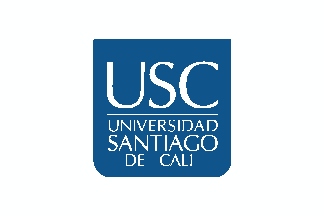 image by Zoltan Horvath, 11 March 2014
image by Zoltan Horvath, 11 March 2014
The USC (Universidad Santiago de Cali, Santiago de Cali University)
was established on October 16, 1958.
Source:
http://es.wikipedia.org/wiki/Universidad_Santiago_de_Cali
Its flag is the
logo on a white horizontal flag as seen
here
(second flag from left to right)
Source:
http://www.usc.edu.co/noticias/index.php/iquienes-somos/765-365-dias-de-transformacion-de-la-santiago
For additional information go to: USC (official website)
Esteban Rivera, 11 March 2014
Faculty of Law and Political Sciences
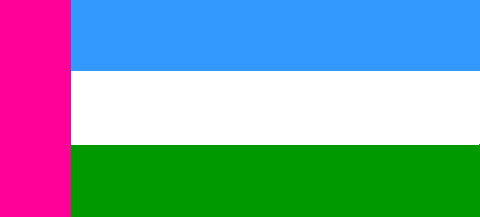 image by Ivan Sache, 25 December 2002
image by Ivan Sache, 25 December 2002
Faculty of Law and Political Sciences, University Santiago of Cali - The image of the flag, shown
without comments on the aforementioned website, is a bit
problematic. The flag is made of three horizontal stripes,
blue-white-green, and a vertical pink stripe is placed along the
hoist. The overall proportion of the image is 100:222, but
excluding the vertical stripe, we have a 1:2 flag! The colours
seem also to be weird, especially the pink, but they are derived
from the University shield, which is shown with a blue field, a
green border and pink writings.
Source: www.usaca.edu.co/derecho,
located by Dov Gutterman.
Ivan Sache, 25 December 2002
 image by Ivan Sache, 13 May 2021
image by Ivan Sache, 13 May 2021
Escuela Normal Superior Santiago de Tunja, located in Tunja, Department of
Boyacá, dates back to Escuela Normal Nacional de Varones de Tunja, founded in
1870. This was part of a national program of refoundation of the Normal Schools
in the states' capitals, managed by the first German Mission in Colombia.
Classes started on 22 September 1872. In 1925, the institute adopted the "New
School" model, promoted by Rafael Bernal Jiménez in the Department of Boyacá
following a conference given by the educationalist Ovidio Decroly in Boyacá. The
reformed institute was the cradle of the Faculties of Educational Sciences
founded in Bogotá and Tunja, for women and men, respectively, part of the
Educational and Technological University of Colombia. Since then, Escuela Normal
Superior Santiago de Tunja has been an annex of the University. The institute
caters today 3,500 alumni scattered over three seats (Central, Jardín Infantil
and Parque Pinzón).
The flag of Escuela Normal Superior Santiago de Tunja is horizontally
divided red-blue-white-blue-red (1:1:2:1:1). Blue means knowledge, white
means purity and joy, red means watch.
Source: school blog
Ivan Sache, 18 Nov 2010 / 13 May 2021
"Institución Educativa Departamental 'Santiago
Pérez'", based at Zipaquirá, Department of Cundinamraca,
was recognized on 29 September 1975, as "Colegio
Departamental 'Santiago Pérez'", by the Department of
Cundinamarca (Decree No. 31054); classes started on 1 February
1976. The current institute was formed on 30 September 2002
(Decree No. 3395) by the merging of "Colegio Departamental
'Santiago Pérez'", "Jardín Infantil 'Carrusel'"
and "Colegio Básico Portachuelo"
The flag of the institute, according to photos taken in 2008 and
the description available on the website of the institute, is
horizontally divided light blue-yellow-red (1:2:1) with the
emblem of the institute in the middle of the yellow stripe.
The flag and arms of the institute were approved by the Rector on
5 August 1976 - but the flag is subsequently said to have been
designed by teacher Fabio Restrepo Parra in 1977!
The colours are the same as on the flags of Colombia and
Cundinamarca. Blue represents the celeste heavens and the
crystalline waters of Zipaquirá. Yellow represents the resources
of the soil, as gold mined by the first inhabitants and local,
modern agriculture based on wheat cropping. Red represents the
"torrents of blood" shed by the local martyrs for
peace, independence and liberty.
The emblem of the institute is circular, emerald green to
represent the aspirations of the students and of the Colombian
youth and the natural resources of the mountains surrounding the
valleys of Zipaquirá, Ubaté and Chiquinquirá (that is,
emeralds). The interlaced letters "C",
"S", "P" and "Z" recall the name of
the institute "Colegio Santiago Perez Zipaquirá". The
white "Z" symbolizes the colonial, salt-mining town of
Zipaquirá. The extreme parts of the letters mark the four main
compass directions. The white ring surrounding the emblem
represents candor and purity of the inhabitants of Zipaquirá and
innocence of the students. "DPTO. DE CUNDINAMARCA" is
written in golden letters on the ring.
This is how the emblem appears on the flag photographed in 2008,
see for instance here.
The symbols'
page on the website of the institute shows three different
representations of the emblem, none of which exactly matches the
emblem actually used on the flag, and a graphic of the flag with
the most recent emblem, with letters "I",
"S", "P" and"Z" reflecting the new
name of the institute and the name of the department dropped from
the border. See also photo
gallery.
Ivan Sache, 7 January 2009
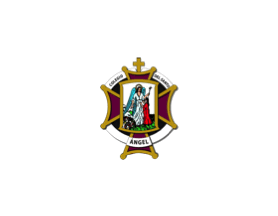 image by Ivan Sache, 03 September 2017
image by Ivan Sache, 03 September 2017
"Colegio del Santo Ángel" was founded in 1958 in
Bogotá by the Congregation of the Sisters of the Guardian Angel.
Founded in
1839 in Quillan (Languedoc, France) by Father Louis Antoine
Ormières and Mother Saint Pascal Lavrilloux, the congregation
was recognized by Napoléon III in 1852 and by Pope Leo XIII in
1902. Following the expelling of the religious congregations from
France in the early 20th century, most sisters relocated to
Spain, where they were known as the "French Sisters".
Their first presence in South America was in Venezuela, in 1950.
See also: catholique-montauban.cef.fr.
The flag of the institute, as shown graphically and described on
the website
of the institute, is white with the emblem of the institute
in the middle.
White represents purity, liberty and transparency.
The emblem of the institute shows a guardian angel
guiding a child about to cross a bridge over a brook in a forest
landscape. The scene is placed over a red cross bordered in
yellow and surmounted by a yellow Latin cross. The emblem is
inscribed in a white ring bearing the black writings
"COLEGIO DEL SANTO ÁNGEL / 1839 / BOGOTÁ / 1958".
1839 and 1958 are the foundation years of the congregation and of
the institute, respectively. Red and white represent love and
purity.
Ivan Sache, 8 January 2009
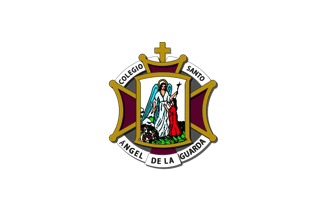 image by Ivan Sache, 03 September 2017
image by Ivan Sache, 03 September 2017
Colegio Santo Ángel de la Guardia was established in La Rinconada ward,
Cúcuta, by the Congregation of the Sisters of the Guardian Angel.
Founded in 1839 in Quillan (Languedoc, France) by Father Louis Antoine Ormières
and Mother Saint Pascal Lavrilloux, the congregation was recognized by Napoléon
III in 1852 and by Pope Leo XIII in 1902. Following the expelling of the
religious congregations from France in the early 20th century, most sisters
relocated to Spain, where they were known as the "French Sisters". Their first
presence in South America was in Venezuela, in 1950
Source: catholique-montauban.cef.fr.
The flag of the institute is white with the institute's emblem in the middle,
the same as for the Bogotá college, with adapted writing.
Source: Institute website
Ivan Sache, 28 March 2016
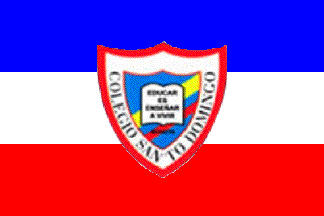 image by Ivan Sache, 28 June 2014
image by Ivan Sache, 28 June 2014
Colegio Santo Domingo was established in Bogotá in January 1977. The
institute is named for St. Dominic Savio 1842-1857), an Italian student of St.
John Bosco, canonized on 12 June 1954 by Pope Pius XII and proclaimed the patron
saint of schools worldwide.
The flag of the institute is horizontally divided blue-white-red, with the
institute's emblem in the middle. Blue is a symbol of academics, study,
learning, knowledge and aspiration to intellectual progress. White is a symbol
of purity, spirituality, love of God and respect of the institute's patron
saint, St. Dominic Savio. Red is a symbol of valiance, solidarity and constancy.
The emblem of the institute features on a blue field, representing knowledge, an
open book, recalling that education should matter everybody, and the flag of
Colombia, placed diagonally.
Source:
http://www.colegiosantodomingo.edu.co/simbolos.php
Photos:
http://www.colegiosantodomingo.edu.co/img/izada/8.jpg
Ivan Sache, 28 June 2014
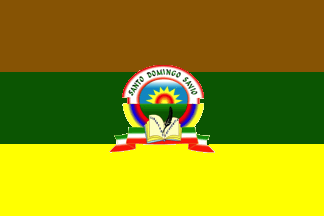 image by Ivan Sache, 15 June 2018
image by Ivan Sache, 15 June 2018
Institución Educativa Santo Domingo Savio is located in Planadas (Tolima
Department). The institute is composed of 8 seats: Santo Domingo Savio, Santa
Teresita del Niño Jesus, El Silencio, Pueblitos, San Pablo, San Gabriel, Las
Margaritas, and San Gabriel Alto.
The institute is named for St. Dominic Savio (1842-1857; canonized on 12 June
1954 by Pope Pius XII), a student of St. John Bosco, who popularized his piety
in the book "Vita del giovanetto Savio Domenico, allievo dell'Oratorio di San
Francesco di Sales" (1859).
The flag of IE Santo Domingo Savio is horizontally divided coffee
brown-green-yellow with the institute's emblem in the center.
Coffee brown is a tribute to the soil on which the new school was built after
the original one had been destroyed by an earthquake.
Green represents hope for the children who can access the educational service
provided by the institute.
Yellow is a symbol of joy with which knowledge is taught and learned in
classrooms.
The shield features on a blue background representing firmament a beautiful sun,
a symbol of the light that shines in the classrooms and in the education
processes used in the institute; the flag of Colombia placed on a green
background, representing natural resources and hope; an open book and a quill,
inscribed with the fundamental values of the institution "Liberty and
Excellence", placed on the municipal flag representing projection to a future
filled with knowledge for the benefit of the community.
Source: IE Santo
Domingo Savio website
Ivan Sache, 15 June 2018
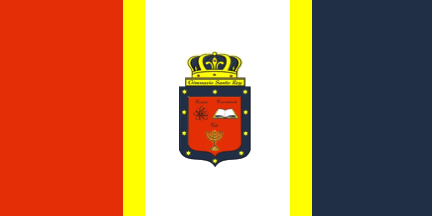 image by Ivan Sache, 23 February 2019
image by Ivan Sache, 23 February 2019
Colegio Gimnasio Santo Rey (GSR) is located in Armenia (Quindío Department).
"Santo" (Saint) recalls that sanctity is God's attribute and highlights God's
moral excellence. God is saint and serves as a model of purity for all living
organisms. "Rey" (King) recalls that God is the King of kings and the Lord of
lords.
The flag of GSR is vertically divided red-white-blue with two thin
vertical yellow stripes surrounding the white stripe and the school's coat of
arms in the center.
The coat of arms is composed of a shield representing
protection granted by God to his children. The tens stars of David in the
bordure are a symbol of excellence. In the field, the atom symbolizes science ("ciencia"),
the book symbolizes knowledge ("conocimiento"), and the Menorah (a Jewish
symbol) represents life ("vida", as the tree of life). The shield is surmounted
by a crown, a symbol of God's kingdom, power and majesty. The fleur-de-lis is a
symbol of the Trinity (the Father, the Son and the Holy Spirit).
Blue
represents the sky, the place of God's throne.
Red represents the blood shed
by Jesus on the cross.
http://www.gimnasiosantorey.edu.co/moodle/mod/page/view.php?id=19079, GSR
website
Ivan Sache, 23 February 2019
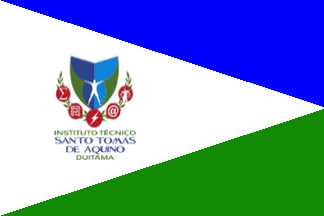 image by Ivan Sache, 12 December 2020
image by Ivan Sache, 12 December 2020
Instituto Técnico Santo Tomás de Aquino (ITSTA) was established in Duitama
(Boyacá) in 1992, as the merger of Instituto Nacional de Promoción Social de
Aguatendida and Concentración Tundama.
ITSTA teaches some 2,100 students in
three seats: Central, Tundama, and El Carmen.
The flag of IT Santo Tomás
de Aquino is horizontally divided blue-green by a white triangle spreading from
the hoist to mid-fly.
White represents faith, purity and safety. It has a
positive connotation and indicates a good start.
Blue represents knowledge,
integrity, seriousness, power, truth, stability and deepness.
Green
represents growth, safety, hope, harmony and exuberance. It is the color of
environment par excellence.
The flag represents the institution's growth,
leadership and significance, through knowledge offered to students. Young people
with critical minds, leadership respecting people and environment, they will be
creative and ingenious, as reflected in each of their specialties.
The
shield uses the institutional colors, green, blue, white and red.
The human
silhouette represents the person as the focus of the human-oriented teaching
offered by ITSTA.
Beneath the shield are shown the specialties taught at
ITSTA, from left to right: Mathematics and Statistics, Electronics, Electricity,
Computer Science, Fashion Design.
https://santoto.edu.co/simbolos/
ITSTA website
Ivan Sache, 12 December 2020
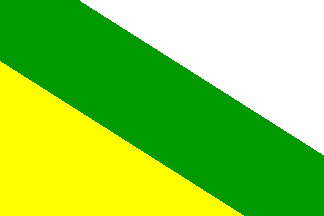 image by Ivan Sache, 17 November 2014
image by Ivan Sache, 17 November 2014
Institución Educativa Técnica Santo Tomás is located in Cuatis Corregimiento,
part of the municipality of Gualmatán (Nariño Department). The institute is
named for St. Thomas Aquinas (1225-1274, canonized on 18 July 1323 by Pope John
XXII and promoted Doctor of the Church in 1568 [Doctor angelicus - Doctor
communis]).
The symbols of the institute were adopted on 20 October 1999. The flag, designed
by the 3rd grade student Digna Isabel Chavez Rosero, is diagonally divided
white-green-yellow according to the descending diagonal. White, green, and
yellow represent the region's peace, vegetation, and resources, respectively.
Source:
http://ietsat.webnode.com.co/oferta-educativa/simbolos/ - Institute's
website
Ivan Sache, 17 November 2014
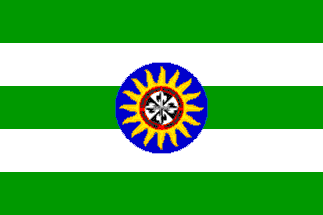 image by Carlos Thompson, 28 May 2003
image by Carlos Thompson, 28 May 2003
Note: this image is incomplete - see below.
Translated from Universidad Santo Tomás websites: www.usta.edu.co
(Bogotá) and www.ustabuca.edu.co
(Bucaramanga, Santander):
"The flag is composed by five horizontal bands, three in
green and two white alternated, the university shield in the
middle and in the top the national tricolor in triangle".
The pictures do not show the flag completely , so I know I miss
the "national tricolor in triangle", this should mean a
triangle of yellow, blue and red.
Carlos Thompson, 28 May 2003
"Universidad Santo Tomás", the First Universitary
Convent in Colombia, was founded in Santa Fé de Bogotá by the
Dominican Order on 13 June 1580. Founded in 1608, "Colegio
Santo Tomás" was subsequently merged with "Universidad
de Estudios Generales" to form "Colegio-Universidad
Santo Tomás", later renamed "Universidad
Tomástica".
On 7 March 1965, the Dominican Order's Province of San Luis
Bertrán de Colombia restored "Universidad Santo Tomás de
Colombia", which was recognized by the Ministry of National
Education on 6 August 1965 (Decree No. 3645). The university
opened regional seats in Bucaramanga (1973), Boyacá (1996) and
Medellín (1997).
On the new
symbols' page of the university, the discrepancy reported by Carlos
Thompson has vanished since there is no longer mention of
the national flag in corner.
The shield of the university is a blue disk charged with a black
and white Cross of Calatrava, surrounded by a red ring bearing in
black capital letters the university's name (top) and motto
(bottom), "Facientes Veritatem", in Latin,
"Furthering Truth", and 16 golden rays representing the
"Sun of Aquino", that is the knowledge of St. Thomas of
Aquino.
Ivan Sache, 28 December 2008
"Colegio Santo Tomás de Aquino", "Dean of the
Colombian Colleges", was founded by the Dominican Order in
Santa Fé de Bogotá in 1573 and refunded in the same town in
1949. It is one of the six colleges ran by the Order, together
with the "Universidad Santo Tomás", in Colombia
(Province of San Luis Bertrán of the Order).
The flag of the college,
as shown on a photo and described on the college
website, is horizontally divided yellow-blue-yellow (1:2:1)
with a sun near the fly and (seemingly) the coat of arms of the
college near the hoist.
Blue symbolizes liberty, to be compared with the infinite blue
sky, immense and inexplorable, a free space for the flight of the
birds, the lightning of the constellations and the transit of the
clouds that water the earth.
Yellow represents wisdom, to be compared with incandescence and
light, the golden base of knowledge and the crucible of word
through radiated truth, born from the infinite fire.
The sun is the Sun of Aquino, united with chains, representing
St. Thomas of Aquino's knowledge instilled in all of his
writings. The sun shown on the flag is more complex than the sun
emblem of the college placed in the middle of the crest of the
coat of arms of the college. It has more rays, is plain yellow
and bears a black ring inside (maybe a chain?).
The coat of arms of the
college is made of the Cross of Calatrava countercoloured black
and white, as the specific symbol of the Dominican Order, with a
blue border charged with the yellow writing "VERITAS COLEGIO
STO. TOMAS DE AQUINO", and surmonted by a crenelled crown
charged with a yellow chain and sun, alluded to in the anthem of
the college.
Black, as absorbing light, represents interiorization and
appropriation of knowledge. White, as the lack of colour and the
plenitude of light, represents truth reveealed to mankind and
enlighting it.
The "Identidad Corporativa" booklet of the college,
available as a PDF
file on the website of the college, includes a detailed
construction sheet of the coat of arms, last amended in 2006.
The prescribed shades are:
- Blue: Pantone 2935c / CMYK 100-47-0-0
- Yellow: Pantone 109c / CMYK 0-9-94-0.
Ivan Sache, 2 January 2009
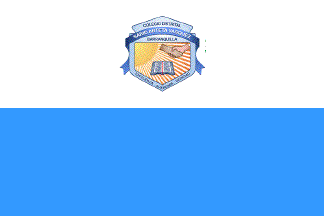 image by Ivan Sache, 25 July 2014
image by Ivan Sache, 25 July 2014
Colegio Distrital Sarid Arteta de Vasquez was established in Baranquilla
(Atlántico Department) on 13 February 1964 by Leticia Herrera de Ramos.
The flag of the institute is horizontally divided white-blue with the
institute's emblem the white stripe.
http://colegio-saridartetadevasquez.barranquilla.edu.co/VM/article/?id=AR00010221
- Institute's website
Ivan Sache, 25 July 2014